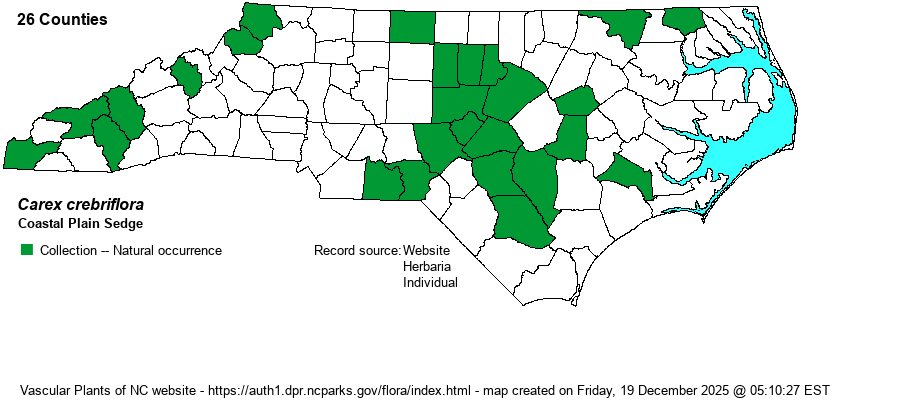| Author | Wiegand | |
| Distribution | Inner Coastal Plain and lower Piedmont; disjunct to low elevations in the Mountains. Extends along the Cape Fear River to Bladen County. The gap in the Piedmont is difficult to explain.
VA, KY, and AR south to northern FL and TX. | |
| Abundance | Generally uncommon in the lower Piedmont and upper Coastal Plain, plus the Mountains. Very rare to absent elsewhere, but ought to be present in the western Piedmont. Plants may be locally common in favorable sites, such as the Cape Fear River floodplain. | |
| Habitat | Upper terraces and margins of floodplain forests, bottomland forests -- where the soils are nutrient-rich. |
| Phenology | Flowering and fruiting late April-June. | |
| Identification | Coastal Plain Sedge belongs to Section Laxiflorae, so care must be taken in keying out. The base of the plant is brownish (vs. red-purple in some other species), female spikes are bunched together with the male spike at the top of the flowering stem (vs. separated in C. styloflexa, C. chapmanii, and most C. blanda), mature perigynia beaks are straight (vs. abruptly bent in C. blanda), and perigynia and scales usually are whitish (vs. green in the others). | |
| Taxonomic Comments | None
The genus Carex is the largest in North America, and among the largest in the world. In temperate and boreal regions, Carex is often the dominant or co-dominant ground layer in many habitats. Seeds (achenes) are valuable food for birds and small mammals, while foliage is used by birds and mammals to make nests and as food by mammals. Species of Carex often look vastly different from one another -- spikes erect vs. drooping, tiny inflorescence vs. whopping, culms leafy vs. naked, perigynia beaked vs. beakless, stems densely bunched vs. single, etc. The genus has been divided into many sections (or groups), based on shared characters; some taxonomists have suggested that these be different genera, but that proves unworkable (so far). All Carex share the feature of a perigynium (an outer covering) which completely surrounds the achene (seed). This covering may fit tightly or loosely (like a small bladder), depending on which group or species. Details of perigynia shape, ornamentation, presence and size of beak, number of striations (or veins) are all important ID features. In recent years Rob Naczi and colleagues have stressed the importance of arrangement of perigynia -- whether spiral (3+ ranks) or distichous (2-ranked) -- and have named a number of new species as well as split off some older synonyms. Therefore, RAB's (1968) key, excellent for its time, can only be used in a general way today. Members of some sections of Carex are difficult to key out (notably Ovales, Laxiflorae, Griseae); this is in part due to variation among individuals of a species, or failings of the key. FNA has drawings of most species and some species may be found in two or more places within a key, to acount for variability. New species to NC, and new to science(!), continue to be found in NC. | |
| Other Common Name(s) | None | |
| State Rank | S2? [S3] | |
| Global Rank | G4 | |
| State Status | | |
| US Status | | |
| USACE-agcp | FACW link |
| USACE-emp | FACW link |

